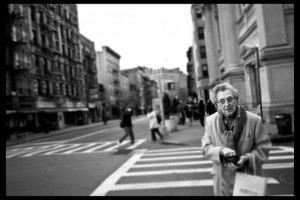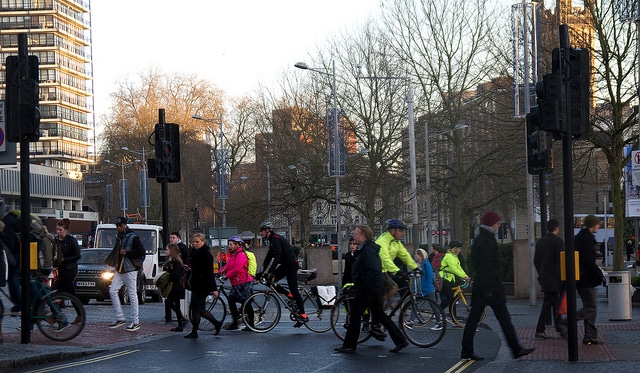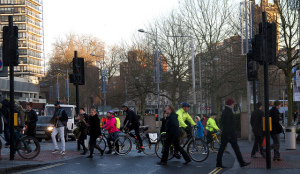Within the end of the day, 445 people will be in the emergency room due to a pedestrian-related traffic accident. In the next two hours, one of those pedestrians will die, reports the National Highway Traffic Safety Administration.
As a pedestrian, it’s important to know how to stay safe when you’re near traffic.
A pedestrian is defined in the Pedestrian Safety Manual as “any person who is traveling by walking for at least part of his or her journey. In addition to walking, a pedestrian may be using various modifications and aids to walking such as wheelchairs, motorized scooters, walkers, canes, skateboards, and roller blades. The person may carry items of varying quantities, held in hands, strapped on the back, placed on the head, balanced on the shoulder, or push/pulled along. A person is also considered a pedestrian when running, jogging, hiking, or when sitting or lying down in the roadway.”
Table of Contents
What causes pedestrian injuries and deaths?
So what causes these major pedestrian accidents? When a car strikes a pedestrian, the severity of the injury depends on the speed, type, and shape of the car. It also depends on the age and height of the pedestrian and whether or not they were in a standing position when they were hit. Serious injury can be found throughout the body especially the head, brain, and pelvis.
Speed:
- Watch out: Faster means more fatal. The faster the car is going, the shorter the amount of time the driver has to stop to avoid impact. If a car is travelling at 30 mph it will require 118 feet to stop. At 30 mph only 5 out of 10 pedestrians hit by a vehicle will survive. At 40 mph, only 1 out of 10 pedestrians will survive.
- Wait to walk, if in doubt of crossing safety. As a pedestrian, it is hard to judge the speed of oncoming vehicles. It is always better to wait if you have any doubts. Speed is directly correlated to the survival of victims struck by a car.
- Teach your teens to drive slow. On average, teens tend to speed more than other age groups. If you have a teen with a learner’s permit or license, remind them of the dangers of driving too fast.
These facts emphasize how important it is for pedestrians to take measures to stay safe while they are by the roads. Here are a few more lessons to keep in mind.
How can I protect myself as a pedestrian?

- If out at night, take special precautions.
- Wear bright, reflective clothing.
- It’s also a good idea to carry a flashlight. The goal is to be visible.
- If you want to cycle at night, stick to the sidewalk.
- If you want to go for a run, find a track at a local high school or visit the community gym.
- Use the sidewalk or road’s shoulder. If there is a sidewalk available, use it. Sidewalks are designated for pedestrians and it is at a safer distance from flowing traffic. However, if there is no sidewalk available, walk on the shoulder of the road and be sure to face traffic. Facing traffic is important for you and the driver. Both you and the driver will be able to see one another.
- Avoid using your phone when walking. A majority of the population now owns a cell phone, and while it is a useful communication tool, it can also distract you when you are moving. A 2005 study suggests that pedestrians who are talking on their phone are at a greater risk of being hit when crossing roads.
- Avoid using your MP3 player. You want to be able to hear the traffic around you. If a car tries to honk to warn you of their approach, and you have your headphones in, your safety is compromised.
- Use designated crosswalks or intersections. Legally, an unmarked crosswalk exists anywhere there is a public intersection with a sidewalk on at least one side of the road. If there are additional markings–like yellow road paint–these are called marked crosswalks. Both kinds of crosswalks were built on the idea that pedestrians would walk through these locations on a daily basis. The government understood that there needed to be a clear and safe pathway for people who are without a vehicle. Both marked and unmarked crosswalks are equally safe. A study of 1000 marked crossings and 1000 unmarked crossings showed no significant difference in the amount of vehicle and pedestrian accidents.
- Use automated crossings if possible. However, crosswalks with automatic signals at intersections with a traffic light are safer. Don’t get a false sense of safety when crossing a marked or unmarked site. Always be aware of your surroundings.
- Be aware when on a high-traffic road. High-traffic roads increase chances of a pedestrian accident. If you plan to walk near one, be aware of the marked crosswalks with automatic signals.
Right of way: When can I walk?
As a pedestrian, you have the right of way on the roads. However, this does not mean that you can walk onto roads with oncoming traffic whenever you want.
If there are no traffic signals, drivers must slow down or stop their vehicles to allow you to cross. However, if there are traffic signals, the pedestrian is required to follow the traffic instructions. If the pedestrian enters a road without designated crosswalks, they must yield to vehicles.
Drivers are required to yield for pedestrians before they drive onto a sidewalk coming from an alley, building, and private road or driveway in a residential or business area. If there is no sidewalk area, drivers are required to stop at a point where the driver can see oncoming traffic.
Driving with pedestrians in mind
 Of all pedestrians, senior citizens are at a greater risk of vehicle-pedestrian accidents. They accounted for 20% of all pedestrian fatalities in 2012. Senior citizens’ eyesight tends to be weaker, making them more likely to misjudge the distance of cars. Their reduced mobility might cause them to move more slowly across sidewalks as well. They are also frailer than other pedestrians, meaning if they are hit, there is a higher chance of a death. In short, be aware of the elderly walking, offer help when available, and be patient if you are a driver.
Of all pedestrians, senior citizens are at a greater risk of vehicle-pedestrian accidents. They accounted for 20% of all pedestrian fatalities in 2012. Senior citizens’ eyesight tends to be weaker, making them more likely to misjudge the distance of cars. Their reduced mobility might cause them to move more slowly across sidewalks as well. They are also frailer than other pedestrians, meaning if they are hit, there is a higher chance of a death. In short, be aware of the elderly walking, offer help when available, and be patient if you are a driver.
Thinking like a pedestrian when planning roadways and land use
Roadway designs also have a great affect on pedestrian safety. If your community has failed to plan and implement crosswalks or sidewalks, the risk of a pedestrian accident increases. If you believe that there are locations around your town that could benefit from increased pedestrian access, contact your local representative. Pedestrian safety should be an integrated part to new roadway designs and land-use planning.
Know your surroundings and be safe.
Sources: Peds.org, Centers for Disease Control and Prevention, World Heatlh Organization: Pedestrian Safety a Road Safety Manuel for Decision Makers and Practitioners
Photo Credit: Sam Saunders via Creative Commons and A. Strakey via Creative Commons and harminder dhesi via Creative Commons

